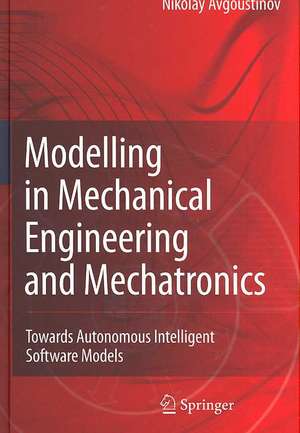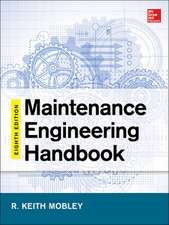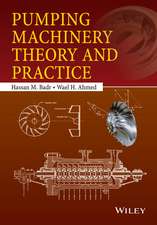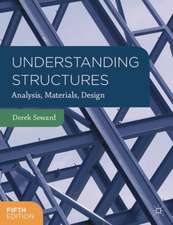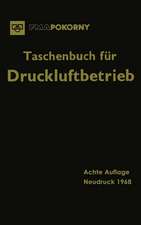Modelling in Mechanical Engineering and Mechatronics: Towards Autonomous Intelligent Software Models
Autor Nikolay Avgoustinoven Limba Engleză Hardback – aug 2007
| Toate formatele și edițiile | Preț | Express |
|---|---|---|
| Paperback (1) | 942.44 lei 6-8 săpt. | |
| SPRINGER LONDON – 12 oct 2010 | 942.44 lei 6-8 săpt. | |
| Hardback (1) | 949.23 lei 6-8 săpt. | |
| SPRINGER LONDON – aug 2007 | 949.23 lei 6-8 săpt. |
Preț: 949.23 lei
Preț vechi: 1157.60 lei
-18% Nou
Puncte Express: 1424
Preț estimativ în valută:
181.69€ • 197.42$ • 152.72£
181.69€ • 197.42$ • 152.72£
Carte tipărită la comandă
Livrare economică 21 aprilie-05 mai
Preluare comenzi: 021 569.72.76
Specificații
ISBN-13: 9781846289088
ISBN-10: 1846289084
Pagini: 255
Ilustrații: XXIV, 226 p. 97 illus.
Dimensiuni: 155 x 235 x 22 mm
Greutate: 0.55 kg
Ediția:2007
Editura: SPRINGER LONDON
Colecția Springer
Locul publicării:London, United Kingdom
ISBN-10: 1846289084
Pagini: 255
Ilustrații: XXIV, 226 p. 97 illus.
Dimensiuni: 155 x 235 x 22 mm
Greutate: 0.55 kg
Ediția:2007
Editura: SPRINGER LONDON
Colecția Springer
Locul publicării:London, United Kingdom
Public țintă
ResearchDescriere
Modelling is an activity that is found in every domain of research and science, and takes place even when we are not aware of it. The role of modelling and the quality of models are extremely important not only in engineering but for science in general.
Modelling in Mechanical Engineering and Mechatronics presents a model-centred approach focusing on distributed development and use of autonomous intelligent software models, particularly the efficiency of the models, and their interaction and integration into distributed autonomous intelligent systems. In order to systematise the available knowledge, a domain ontology is presented; a subset of which is used to create a modelling theory based on knowledge and experience in the areas of software engineering, mechanical engineering and mechatronics. This holistic view of modelling explains the purpose and the essence of modelling, as well as the benefits that are to be expected. It discusses the relations to other branches of engineering and science and as a result, it demonstrates strategies, methods and tools for unleashing the full power of modelling.
Modelling in Mechanical Engineering and Mechatronics considers the viewpoints of many different experts: the modeller, engineer, system architect, software developer, and users of the models and as such will be of interest to all these people. Moreover, it attempts to bridge the gaps between modelling, engineering, computer science, knowledge representation, software engineering, model integration, standardisation and production engineering. The aim is to instruct the reader how to efficiently simulate sophisticated products and processes in mechanical engineering in view of their continuously increasing complexity in a modern knowledge-based society.
Modelling in Mechanical Engineering and Mechatronics presents a model-centred approach focusing on distributed development and use of autonomous intelligent software models, particularly the efficiency of the models, and their interaction and integration into distributed autonomous intelligent systems. In order to systematise the available knowledge, a domain ontology is presented; a subset of which is used to create a modelling theory based on knowledge and experience in the areas of software engineering, mechanical engineering and mechatronics. This holistic view of modelling explains the purpose and the essence of modelling, as well as the benefits that are to be expected. It discusses the relations to other branches of engineering and science and as a result, it demonstrates strategies, methods and tools for unleashing the full power of modelling.
Modelling in Mechanical Engineering and Mechatronics considers the viewpoints of many different experts: the modeller, engineer, system architect, software developer, and users of the models and as such will be of interest to all these people. Moreover, it attempts to bridge the gaps between modelling, engineering, computer science, knowledge representation, software engineering, model integration, standardisation and production engineering. The aim is to instruct the reader how to efficiently simulate sophisticated products and processes in mechanical engineering in view of their continuously increasing complexity in a modern knowledge-based society.
Cuprins
Introduction Modelling Basics Conventioanl Product and Process Modelling Towards Better Product and Process Modelling Conclusion Perspectives Afterword
Notă biografică
Dr Avgoustinov is a lecturer at the Institute of Production Engineering/CAM, Saarland University which is where he gained his Ph.D. in 1997. During a professional career of twenty years, he has acquired experience in the areas of undergraduate and graduate teaching, modeling, software development (3D-visualization, information exchange, web-based services, product and process simulation, etc.), software architecture and integration, information exchange, virtual and mixed reality, modeling for medical purposes, information technology consulting in the area of mechanical and production engineering and others.
Textul de pe ultima copertă
Modelling is an activity that is found in every domain of research and science, and takes place even when we are not aware of it. The role of modelling and the quality of models are extremely important not only in engineering but for science in general.
Modelling in Mechanical Engineering and Mechatronics presents a model-centred approach focusing on distributed development and use of autonomous intelligent software models, particularly the efficiency of the models, and their interaction and integration into distributed autonomous intelligent systems. In order to systematise the available knowledge, a domain ontology is presented; a subset of which is used to create a modelling theory based on knowledge and experience in the areas of software engineering, mechanical engineering and mechatronics. This holistic view of modelling explains the purpose and the essence of modelling, as well as the benefits that are to be expected. It discusses the relations to other branches of engineering and science and as a result, it demonstrates strategies, methods and tools for unleashing the full power of modelling.
Modelling in Mechanical Engineering and Mechatronics considers the viewpoints of many different experts: the modeller, engineer, system architect, software developer, and users of the models and as such will be of interest to all these people. Moreover, it attempts to bridge the gaps between modelling, engineering, computer science, knowledge representation, software engineering, model integration, standardisation and production engineering. The aim is to instruct the reader how to efficiently simulate sophisticated products and processes in mechanical engineering in view of their continuously increasing complexity in a modern knowledge-based society.
Modelling in Mechanical Engineering and Mechatronics presents a model-centred approach focusing on distributed development and use of autonomous intelligent software models, particularly the efficiency of the models, and their interaction and integration into distributed autonomous intelligent systems. In order to systematise the available knowledge, a domain ontology is presented; a subset of which is used to create a modelling theory based on knowledge and experience in the areas of software engineering, mechanical engineering and mechatronics. This holistic view of modelling explains the purpose and the essence of modelling, as well as the benefits that are to be expected. It discusses the relations to other branches of engineering and science and as a result, it demonstrates strategies, methods and tools for unleashing the full power of modelling.
Modelling in Mechanical Engineering and Mechatronics considers the viewpoints of many different experts: the modeller, engineer, system architect, software developer, and users of the models and as such will be of interest to all these people. Moreover, it attempts to bridge the gaps between modelling, engineering, computer science, knowledge representation, software engineering, model integration, standardisation and production engineering. The aim is to instruct the reader how to efficiently simulate sophisticated products and processes in mechanical engineering in view of their continuously increasing complexity in a modern knowledge-based society.
Caracteristici
A novel (model-centred) approach to the subject
Considers the viewpoints of many different experts: modeller, engineer, system architect, software developer, and users of the models
A holistic view which demonstrates strategies, methods and tools for unleashing the full power of modelling
Includes supplementary material: sn.pub/extras
Considers the viewpoints of many different experts: modeller, engineer, system architect, software developer, and users of the models
A holistic view which demonstrates strategies, methods and tools for unleashing the full power of modelling
Includes supplementary material: sn.pub/extras
